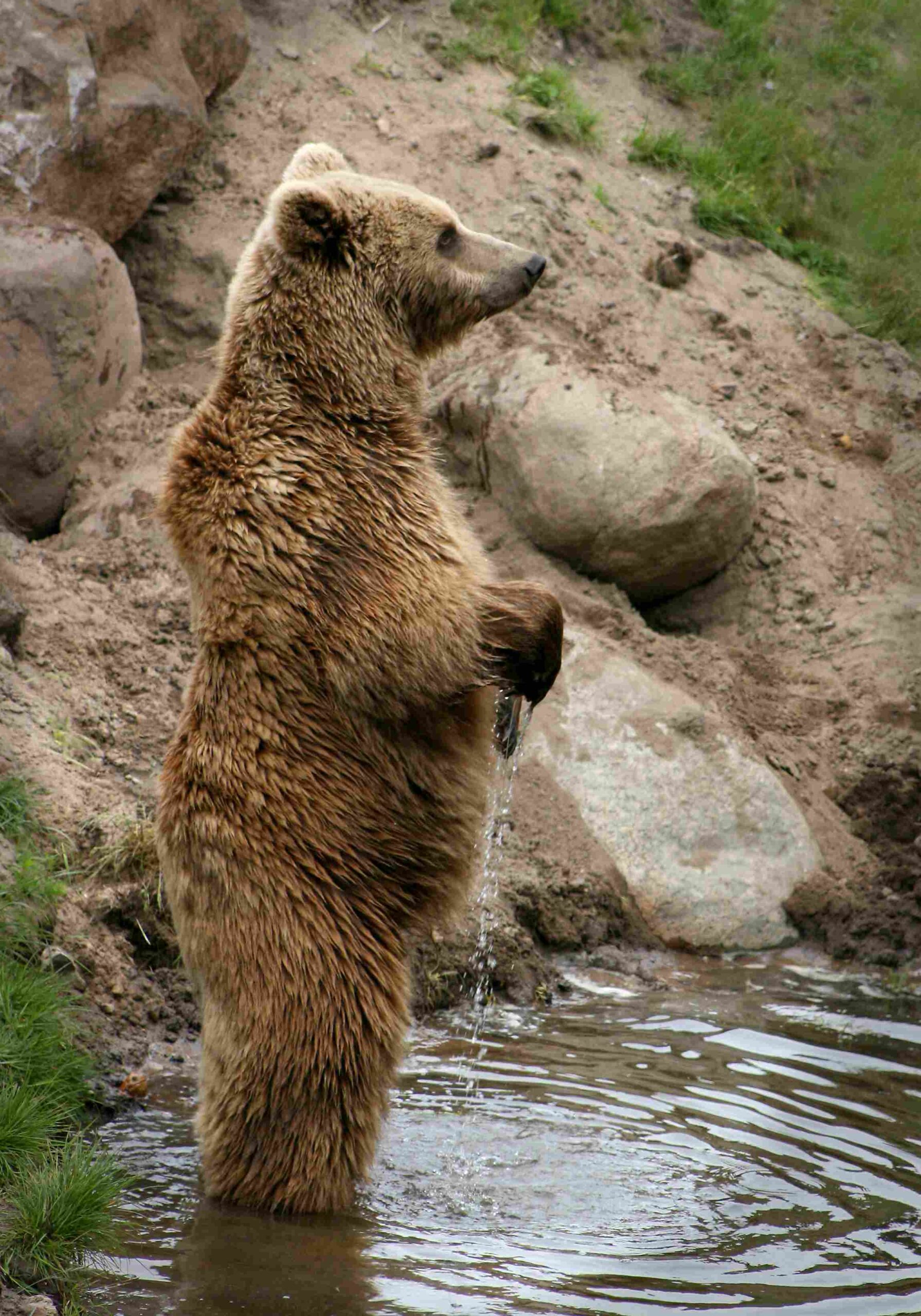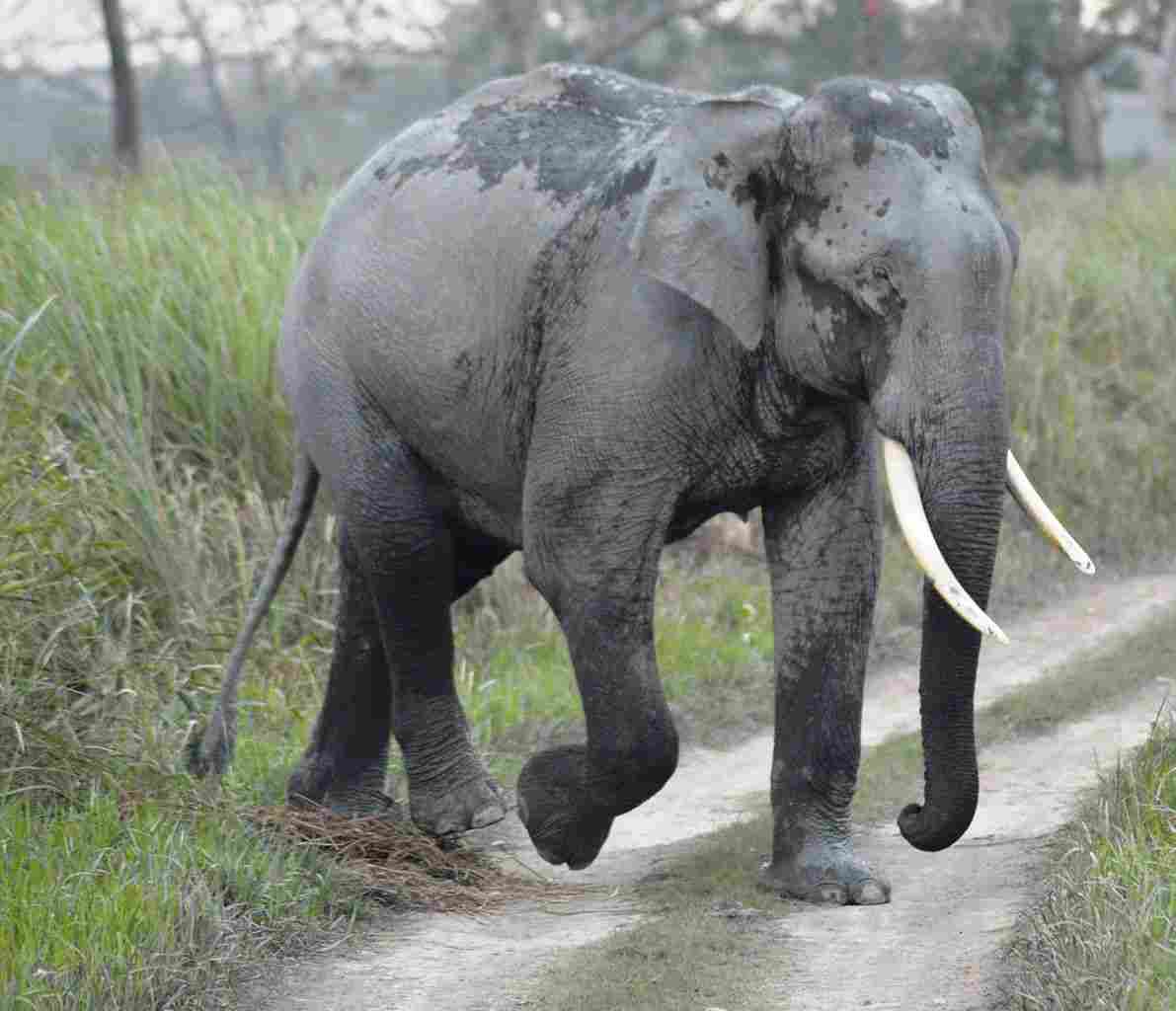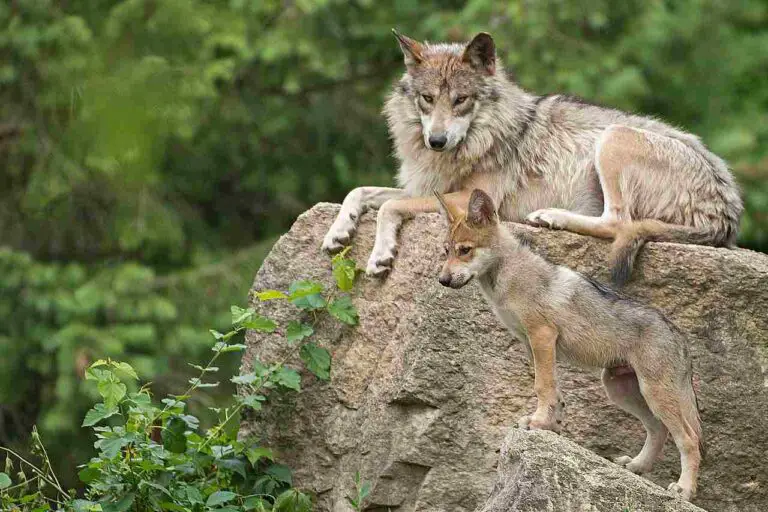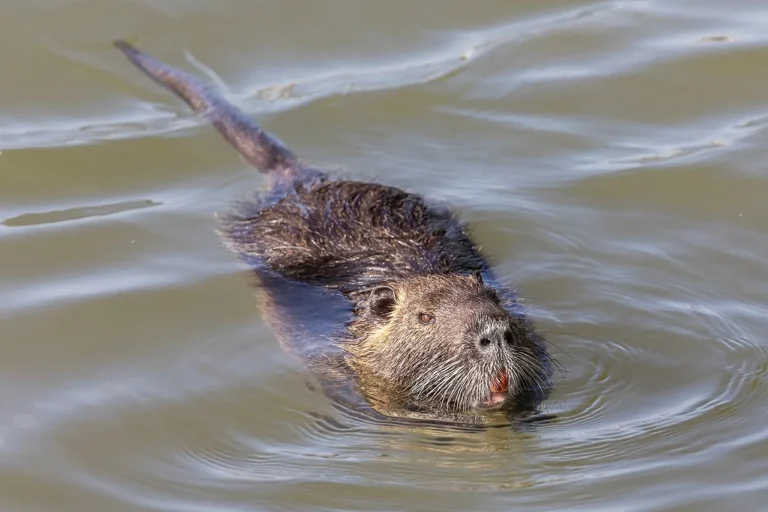Kodiak Bear Vs Short Faced Bear Vs Elephant
The Kodiak bear is at a disadvantage when facing a short-faced bear in a fight. The larger size and weight of the short-faced bear, combined with its predatory features, give it the upper hand.
Similarly, a Kodiak bear would not be able to defeat an elephant due to the sheer size and weight difference, as well as the enormous power of the elephant. In both scenarios, the Kodiak bear is outmatched by its opponents.
Reasons Why a Kodiak Bear Will Not Win a Short Faced Bear in a Fight/Physical Confrontation
I). Size and Weight Advantages of The Kodiak Bear
While the Kodiak bear is an impressive and formidable creature, it is at a disadvantage when facing a short-faced bear in a fight or physical confrontation. The short-faced bear, also known as Arctodus simus, was one of the largest terrestrial mammalian carnivores that ever existed.
It outweighed the Kodiak bear by a significant margin, with estimates suggesting that it could reach weights of up to 3,500 pounds, compared to the average weight of a Kodiak bear, which is around 1,500 pounds. This substantial difference in size and weight gives the short-faced bear a clear advantage in terms of sheer physical power and force.
II). Sheer Muscular Strength and Predatory Capacity
In addition to its size advantage, the short-faced bear possessed exceptional muscular strength and predatory capacity. Its robust build and powerful limbs allowed it to deliver devastating blows and overpower its opponents.
The short-faced bear was an apex predator, adapted for hunting and taking down large prey. Its long limbs and strong jaws, equipped with sharp teeth, made it a formidable adversary in any physical confrontation. The Kodiak bear, while strong in its own right, simply does not possess the same level of predatory capacity and physical prowess as the short-faced bear.
Therefore, the size and weight advantages, coupled with the sheer muscular strength and predatory capacity of the short-faced bear, make it a formidable opponent for the Kodiak bear in a fight or physical confrontation. The Kodiak bear, despite its own impressive attributes, would struggle to overcome the overwhelming advantages possessed by the short-faced bear.

Reasons Why a Kodiak Bear Will Not Win an Elephant in a Fight/Physical Confrontation
I). Differences in Size and Weight
One of the main reasons why a Kodiak bear would not win in a fight or physical confrontation against an elephant is the vast difference in size and weight between the two animals. Kodiak bears are certainly large and powerful creatures, but they pale in comparison to the sheer size and weight of an elephant.
Elephants are the largest land animals on Earth, with males reaching heights of up to 13 feet at the shoulder and weighing as much as 14,000 pounds. In contrast, Kodiak bears typically stand around 10 feet tall and weigh around 1,500 pounds on average. This significant difference in size and weight gives elephants a clear advantage in terms of physical strength and force.
II). Elephants are By Far More Powerful Than Kodiak Bears
Not only are elephants larger and heavier than Kodiak bears, but they are also far more powerful. Elephants possess immense strength, which they use for various activities such as digging, pushing down trees, and defending themselves against predators.
Their muscular trunks alone can exert tremendous force, allowing them to uproot trees and move heavy objects. In comparison, while Kodiak bears are undoubtedly strong, they simply do not possess the same level of power as elephants.
III). Possession of Tusks for Offense and Defense
Another factor that gives elephants an advantage over Kodiak bears is their possession of tusks. Elephants have long, curved tusks that can grow up to 10 feet in length and weigh several hundred pounds.
These tusks serve both offensive and defensive purposes, allowing elephants to defend themselves against predators and engage in battles with other elephants. In contrast, Kodiak bears do not have tusks and rely primarily on their claws and strength for defense.
*Kodiak Bear Vs Short Faced Bear Size, Weight, Taxonomy
a). Taxonomic Classification
When comparing the Kodiak bear and the short-faced bear, it is important to consider their taxonomic classification. The Kodiak bear, scientifically known as Ursus arctos middendorffi, belongs to the genus Ursus and the species arctos.
On the other hand, the short-faced bear, also known as Arctodus simus, belongs to the genus Arctodus and the species simus. Despite their similar genus names, it is important to note that the Kodiak bear and the short-faced bear are not closely related. The Kodiak bear is a subspecies of the brown bear, while the short-faced bear is an extinct species that lived during the Pleistocene epoch.
b). Appearance
When it comes to their appearance, the Kodiak bear and the short-faced bear have some notable differences. The Kodiak bear has a thick coat of fur that can range in color from blonde to dark brown. This dense fur helps to insulate the bear in its cold habitat.
In contrast, the short-faced bear is believed to have had a shorter and coarser coat compared to the Kodiak bear. Additionally, the short-faced bear is thought to have had a more robust build and a shorter snout, which gave it a distinct appearance.
c). Size and Weight Comparison
In terms of size and weight, the Kodiak bear and the short-faced bear were both impressive creatures. The Kodiak bear is one of the largest subspecies of brown bears and can reach heights of up to 10 feet when standing on its hind legs. Adult male Kodiak bears can weigh anywhere between 900 to 1,500 pounds.
On the other hand, the short-faced bear was even larger. It is estimated that the short-faced bear could reach heights of up to 12 feet when standing on its hind legs and weigh between 2,000 to 3,500 pounds. This makes the short-faced bear one of the largest known terrestrial mammalian carnivores.
d). Who Will Win in a Fight Between Them
When considering which animal would win in a fight between the Kodiak bear and the short-faced bear, it is important to take into account their overall strength and physical capabilities. While the Kodiak bear is a formidable predator, the short-faced bear’s larger size and weight give it a significant advantage.
The short-faced bear’s robust build and powerful limbs would likely make it a formidable opponent in a physical confrontation. However, it is important to note that the outcome of such a fight would depend on various factors, including the individuals involved and the specific circumstances of the encounter.
e). Key Differences and Similarities
In terms of intelligence, both the Kodiak bear and the short-faced bear are believed to have been highly intelligent animals. They would have needed to use their intelligence to navigate their respective habitats and find food sources. However, due to the short-faced bear’s larger size and more robust build, it may have had a slight advantage in terms of physical strength.
When it comes to their habitats, the Kodiak bear is found primarily on the Kodiak Archipelago in Alaska, while the short-faced bear inhabited various regions of North America during the Pleistocene epoch.
In terms of danger to humans, it is important to note that both the Kodiak bear and the short-faced bear are powerful predators and should be treated with caution. While the short-faced bear is extinct and no longer poses a threat to humans, the Kodiak bear is still a living species and encounters with humans can be dangerous if proper precautions are not taken.
Therefore, the Kodiak bear and the short-faced bear differ in their taxonomic classification, appearance, size, and weight. While the Kodiak bear is a subspecies of the brown bear and is known for its thick fur and impressive size, the short-faced bear was an extinct species that was even larger and more robust. In a hypothetical fight between the two, the short-faced bear’s larger size and strength would likely give it an advantage.
*Kodiak Bear Vs Elephant Size, Weight, Taxonomy
a). Taxonomic Classification
When comparing the Kodiak bear and the elephant, it is important to consider their taxonomic classification. The Kodiak bear, scientifically known as Ursus arctos middendorffi, belongs to the genus Ursus and the species arctos.
On the other hand, the elephant belongs to the family Elephantidae, which includes three species: the African bush elephant (Loxodonta africana), the African forest elephant (Loxodonta cyclotis), and the Asian elephant (Elephas maximus). While the Kodiak bear and the elephant are both mammals, they are not closely related in terms of taxonomic classification.

b). Appearance
When it comes to their appearance, the Kodiak bear and the elephant have distinct characteristics. The Kodiak bear has a thick coat of fur that can range in color from blonde to dark brown. This dense fur helps to insulate the bear in its cold habitat.
In contrast, elephants have a tough and wrinkled skin that is mostly gray in color. Their skin is sparsely covered with short, coarse hair. Elephants also have large, fan-shaped ears and long, curved tusks, which are elongated incisor teeth. In terms of stature, the Kodiak bear stands on all four legs and has a more compact build, while elephants have a more upright posture and a larger body size.
c). Size and Weight Comparison
In terms of size and weight, the Kodiak bear and the elephant are both impressive creatures. The Kodiak bear is one of the largest subspecies of brown bears and can reach heights of up to 10 feet when standing on its hind legs.
Adult male Kodiak bears can weigh anywhere between 900 to 1,500 pounds. On the other hand, elephants are the largest land animals on Earth. African bush elephants can reach heights of up to 13 feet at the shoulder and weigh between 5,000 to 14,000 pounds. Asian elephants are slightly smaller, with heights ranging from 8 to 10 feet and weights between 4,000 to 11,000 pounds. This makes elephants significantly larger and heavier than Kodiak bears.
d). Who Will Win in a Fight Between Them
When considering which animal would win in a fight between the Kodiak bear and the elephant, it is important to take into account their overall strength and physical capabilities. While the Kodiak bear is a formidable predator, the elephant’s larger size and strength give it a significant advantage.
Elephants have powerful trunks that can be used for defense and offense, as well as long tusks that can cause serious injuries. Additionally, elephants have thick skin that provides protection against attacks. On the other hand, while Kodiak bears are strong and have sharp claws, they would likely struggle to overpower an elephant due to its sheer size and strength. In a hypothetical fight between the two, the elephant’s size and physical abilities would likely give it the upper hand.
e). Key Differences and Similarities
In terms of intelligence, both the Kodiak bear and the elephant are known to be highly intelligent animals. They exhibit complex social behaviors and have the ability to problem-solve. However, elephants are often regarded as one of the most intelligent animals on Earth, with exceptional memory and cognitive abilities.
When it comes to their habitats, the Kodiak bear is found primarily on the Kodiak Archipelago in Alaska, where it inhabits coastal areas and forests. Elephants, on the other hand, have a wider range of habitats. African elephants can be found in various habitats, including savannas, forests, and grasslands, while Asian elephants are found in tropical and subtropical forests.
In terms of danger to humans, it is important to note that both the Kodiak bear and elephants can be dangerous if provoked or if their territories are encroached upon. While Kodiak bears are known to be more aggressive and have been involved in attacks on humans, elephants are responsible for more human deaths each year due to their larger size and potential for aggression.
Therefore, the Kodiak bear and the elephant differ in their taxonomic classification, appearance, size, and weight. While the Kodiak bear is a subspecies of the brown bear and is known for its thick fur and impressive size, elephants are the largest land animals and have distinct features such as their wrinkled skin and long tusks. In a hypothetical fight between the two, the elephant’s larger size and strength would likely give it an advantage.
Conclusion
In conclusion, this article has explored the differences between the Kodiak bear, the short-faced bear, and the elephant in terms of size, weight, and taxonomy. We have discussed how the Kodiak bear and the short-faced bear are closely related, but the elephant belongs to a different family.
We have also examined their appearances, with the Kodiak bear having a thick fur coat and the elephant having tough, wrinkled skin. Additionally, we have compared their sizes and weights, with elephants being significantly larger and heavier than Kodiak bears. Overall, the elephant’s size and strength would likely give it the advantage in a fight against either bear species.


